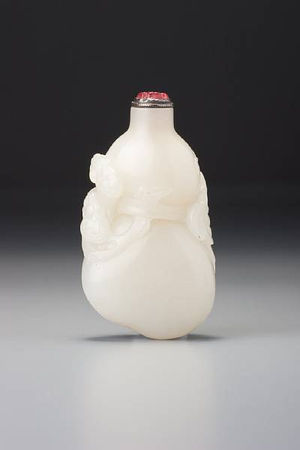A white nephrite double-gourd 'lingzhi' snuff bottle. Possibly Imperial, 1730–1800
A white nephrite double-gourd 'lingzhi' snuff bottle. Possibly Imperial, 1730–1800. photo Bonhams
sold with accompanying watercolour by Peter Suart, 6.73cm high. Sold for HK$264,000
Treasury 1, no. 63
白玉細腰葫蘆靈芝鼻煙壺
或為御製品,1730~1800
The Lingzhi Double Gourd
Nephrite; very well hollowed and carved in the form of a double gourd; with a sash tied in a bow around its waist and holding a double-headed lingzhi; a branch of leaves and tendrils from the vine also disposed across the two bulbs of the gourd
Possibly imperial, 1730–1800
Height: 6.73 cm
Mouth/lip: 0.59/1.20 cm
Stopper: glass; silver collar
Condition: miniscule nibble to the outer lip smoothed; otherwise workshop condition
Illustration: watercolour by Peter Suart
Provenance: Sydney L. Moss Ltd.
C. S. Wilkinson
Hugh M. Moss Ltd. (London, circa 1963)
Cyril Green
Hugh Moss
The Belfort Collection (1986)
Published:
The Connoisseur, February 1966, p. 11
Chinese Snuff Bottles No. 2, p. 27, fig. 1
Snuff Bottles of the Ch'ing Dynasty 1978, p. 100, no. 161
Jutheau 1980, p. 112, fig. 4
Kleiner 1987, no. 32
Bloch Collection Poster (1987), reproduction of watercolours by Peter Suart
Treasury 1, no. 63
Exhibited:
Hong Kong Museum of Art, October–December 1978
L'Arcade Chaumet, Paris, June 1982
Sydney L. Moss Ltd., London, October 1987
Creditanstalt, Vienna, May–June 1993
Israel Museum, Jerusalem, 1997
Commentary: This extraordinary bottle is another of the great masterpieces of the fruit-, and vegetable-form group of bottles and another likely candidate to be from the hand of the 'Castiglione of jade carving' (see discussion under Treasury 1, no. 62 and for another possible candidate, Treasury 1, no. 65). It is also linked through other examples to a possible imperial source, and perhaps the palace workshops, which is also endorsed by the slightly chalky white flaws around the shoulders which are in keeping with other known jade used in the palace (see discussion under Treasury 1, no. 149). In common with so many of the group it is not made to stand but to be held in the hand. Another possibility if it is from the imperial output, whether at Beijing and the palace or some other workshop, is that it was designed originally to have a stand. There is ample evidence to suggest that the rule at court was for wood, ivory, or some other material to be carved as a stand for most works of art and it is possible that this also extended to some snuff bottles. On the other hand, the snuff bottle may have been a general exception since it was made for use primarily in the hand, whereas vases, bowls, small sculptures, objects for the scholar's desk, etc. were all made to be viewed as independent sculpture. To whatever extent these other works of art might also be handled, they were mostly not designed to function primarily in the hand.
The asymmetrical double gourd is superbly well carved. The loosely tied sash, with its calligraphic ends seemingly whipped in the breeze, encloses a double-headed lingzhi which simply knocks all other lingzhi on jade snuff bottles into a cocked-hat for style, execution and sheer visual impact. Simply gazing at it seems to breathe a little of the immortality symbolism it carries into the viewer, and by carving it so brilliantly, the artist who made this bottle certainly achieved for himself a level of immortality. The rest of the carving lives up to the same level of mastery, and the leaves of the severed vine also have some relief and some incised skeletal details, linking the bottle to other similar works (see discussion under Treasury 1, no. 65).
The meaning of the sash (shoudai) denotes longevity (shou), while the knot (jie) can be interpreted as a homophone of another character meaning vast, so together the knot and the sash (jieshou) signify a very long life, which is in keeping with the symbolism of the lingzhi and, when added to the wish for ample progeny of the double gourd, suggests longevity and many offspring.
綬帶葫蘆拴靈芝之扁腹壺
閃玉;掏膛非常規整,雕結綬帶、拴著靈芝的葫蘆、葫蘆藤枝
或為御製品,1730~1800
高:6.73 厘米
口經/唇經:0.59/1.20 厘米
蓋:玻璃,銀蓋座
狀態敘述:作坊狀態,唯唇外沿有已磨圓的細小咬痕
有彼德小話 (Peter Suart) 水彩畫
來源:
Sydney L. Moss Ltd
C. S. Wilkinson
Hugh M. Moss Ltd (倫敦, 約 1963)
Cyril Green
莫士撝
Belfort 珍藏 (1986)
文獻:
The Connoisseur, 1966年2月, 頁 11
Chinese Snuff Bottles 2, 頁 27, 圖 1
Snuff Bottles of the Ch'ing Dynasty, 頁 100, 編號161
Jutheau 1980, 頁 112, 圖 4
Kleiner 1987, 編號32
伯樂珍藏海報 (1987), 彼德小話 (Peter Suart) 水彩畫復製
Treasury 1, 編號63
展覽:
香港藝術館,1978年10 月至12月
L'Arcade Chaumet, 巴黎, 1982年6月
Sydney L. Moss Ltd, 倫敦, 1987年10 月
Creditanstalt, 維也納, 1993年5月至6月
Israel Museum, 耶路撒冷, 1997年7月~11月
說明:
本壺是果實、蔬菜形煙壺傑作之一,品質極高,很可能是我們稱為"玉工之郎世寧"的造辨處玉作高手無名玉工所琢製。肩部像白堊的微瑕與其他若干宮廷玉器是一致的。宮廷的寶器常常帶木座或象牙座,這個煙顯然也要架子或座,雖然煙壺本質上是手持物,不一定有足,但將本壺安放在座上而擺在宮殿裏供皇家、大官欣賞,跟其他宮廷玉器的情況也是一致的。
雕呈的一莖靈芝有兩頭,獨特的樣式、精巧的雕琢,都讓別的靈芝大為遜色了。視之有紫芝可採三山近之感;玉工呢,的確是遺物後人守,修成垂不朽。葫蘆葉葉脈有的是陰線刻的,有的是浮雕的, 這和伯樂珍藏中另外一些軟玉煙壺相同。
Bonhams. Snuff Bottles from the Mary and George Bloch Collection: Part I, 28 May 2010 to 29 May 2010. JW Marriott Hotel www.bonhams.com

/https%3A%2F%2Fprofilepics.canalblog.com%2Fprofilepics%2F1%2F0%2F100183.jpg)









/http%3A%2F%2Fstorage.canalblog.com%2F54%2F28%2F577050%2F66207373_o.jpg)
/http%3A%2F%2Fstorage.canalblog.com%2F38%2F35%2F577050%2F66167687_o.jpg)
/http%3A%2F%2Fstorage.canalblog.com%2F77%2F77%2F577050%2F66151319_o.jpg)
/http%3A%2F%2Fstorage.canalblog.com%2F71%2F09%2F119589%2F66118115_p.jpg)